Radioactive Waste
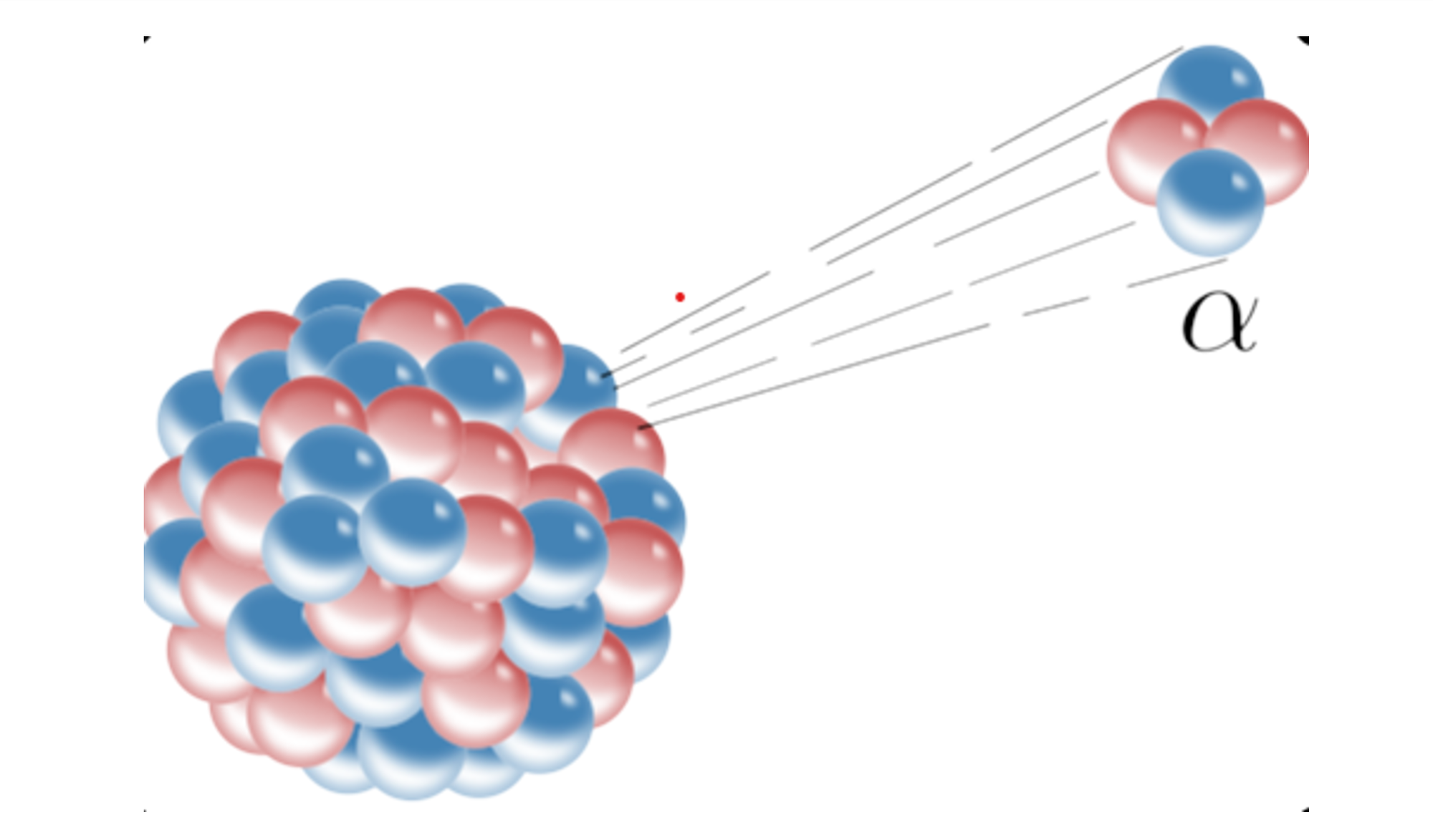
Advocates of fusion frequently claim that radioactive waste from fusion reactors is not an issue, sometimes saying the waste is safe after 100 years and in some cases even saying there is no radioactive waste. The facts about radioactivity in fusion nuclear reactors are presented below showing that large quantities of waste remain radioactive for more than 1000 years.
Many of the concepts used here are explained in the page Essentials of Nuclear Physics. Graphs frequently use logarithmic scales which are often a cause of misunderstanding, so this is also explain in the Essentials page.
Neutron activation
In nuclear fission reactors, the dominant source of radioactivity is from the breakup of the uranium nuclei, leading to radioactive isotopes. In fusion the primary reactions leave no residual radioisotopes, apart from unburnt tritium, but the neutrons emitted from the reaction create radioactive isotopes when they hit the surrounding material. This process is called neutron activation.

The difficulties for fusion reactors arise from impurities in metals which lead to a long-lived radioisotopes. The appearance of impurities in different metals has numerous causes, from the original ore to the refining methods themselves. The complexities of evaluating the neutron activation rates of everything in a fusion power plant are enormous, and it is quite possible that some effects might be overlooked and only be discovered when the facilities come into operation.
Development of low activation materials
Extensive research and development has been conducted since the 1970s to develop new materials with the aim of minimizing enduring radioactivity in fusion reactors. For this it is necessary to avoid the use of elements which can be activated to isotopes with long lifetimes. This has involved finding alloys without certain elements which have undesirable activation products. Four main classes of low-activation structural materials have been developed: ferritic/martensitic steel, silicon carbide composites, tungsten alloys, and vanadium alloys. The figure below (from Taylor et al.) shows the specific activity of the four structural materials subject to the same radiation environment as the plasma facing surfaces of a typical tokamak.
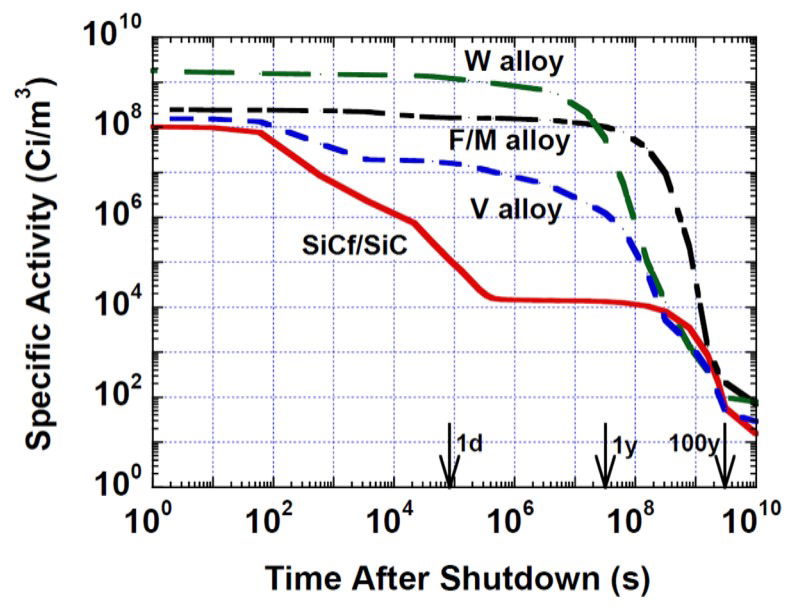
Specific activity of tokamak first wall made of: silicon carbide fibre/silicon carbide composites (SiCf/SiC); ferritic/martensitic steel (F/M); vanadium(V); tungsten (W) alloys
The paper by Bailey et al. gives details of waste expectations of fusion steels. The plot below, taken from this paper, gives the levels of β + γ radiation for different types of steel in the vacuum vessel and blanket as a function of time after the tokamak end-of-life (EOL).
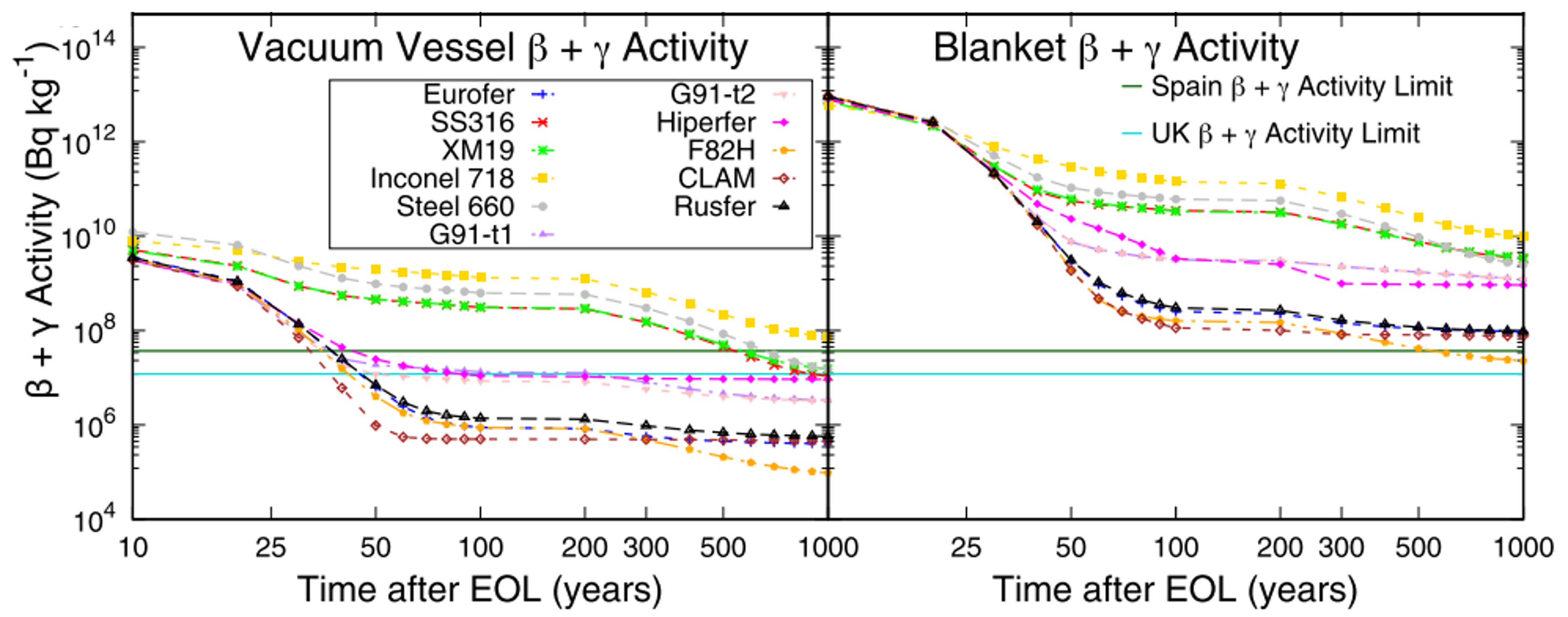
The total β + γ specific activities for tokamak vacuum vessel and blanket. The β + γ limits for Low Level Waste criteria for the UK and Spain are plotted for reference with the solid lines.
From this plot for the vacuum vessel, after 50 years five steels can meet the UK limit. In contrast for the blanket, no steels can make the UK limit before 1000 years.
Levels of radioactivity for waste
DEMO is planned as the first mainstream fusion power plant. The design uses Eurofer for the most highly irradiated structural components and tungsten for the plasma facing wall.
The levels of radioactivity in fusion reactors are estimated in reactor design studies. The figure below from, Gilbert et al., illustrates the radioactivity levels in parts of the vacuum vessel after the end of DEMO operations. The longest lasting radioactivity is due to nickel radioisotopes and carbon-14.
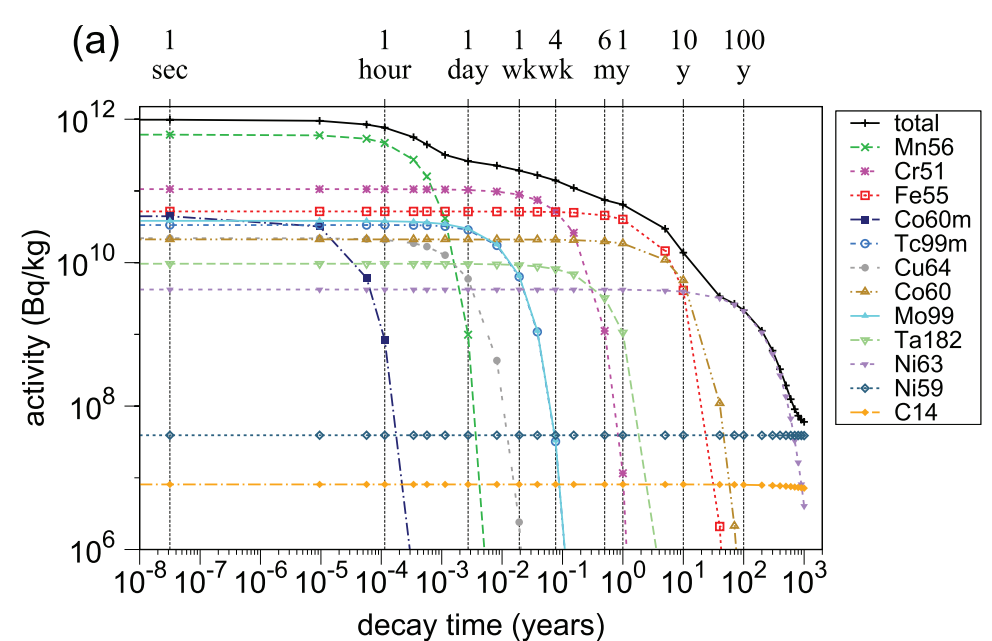
Radioactivity decay of the vacuum vessel of DEMO after operations. The different isotopes contributing to the total are indicated with Nickel-63, Nickel-59 and Carbon-14 having the longest lifetimes.
The figure below from Gilbert et al., shows the timescales when the radioactivity in components has decayed to levels of Low-Level Waste (LLW). The blanket modules, the divertor and the inner part of the vacuum vessel would remain at the radioactivity levels of Intermediate-Level Waste (ILW) for more than 1,000 years.
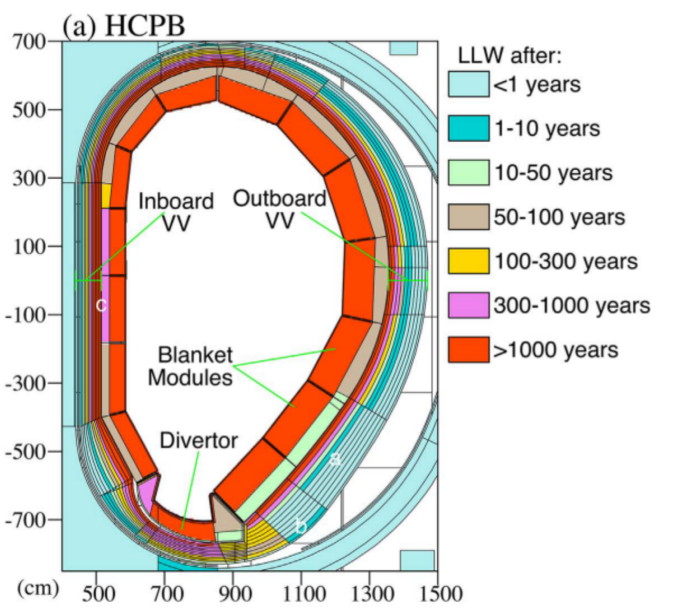
Indication of radioactivity in DEMO inner layers, giving the timescale to become Low Level Waste (LLW).
Impurities
There is significant uncertainty in what will be the real radioactivity levels for actual constructions, because of the strong dependence on the impurities in the finally delivered materials. The figures below give an example of tungsten, which is used for the first wall closest to the plasma, where small impurities (0.001 % Cobalt) add significant amounts of long-lived radioisotopes such as Tantalum-179, Cobalt-60 and Argon-39.
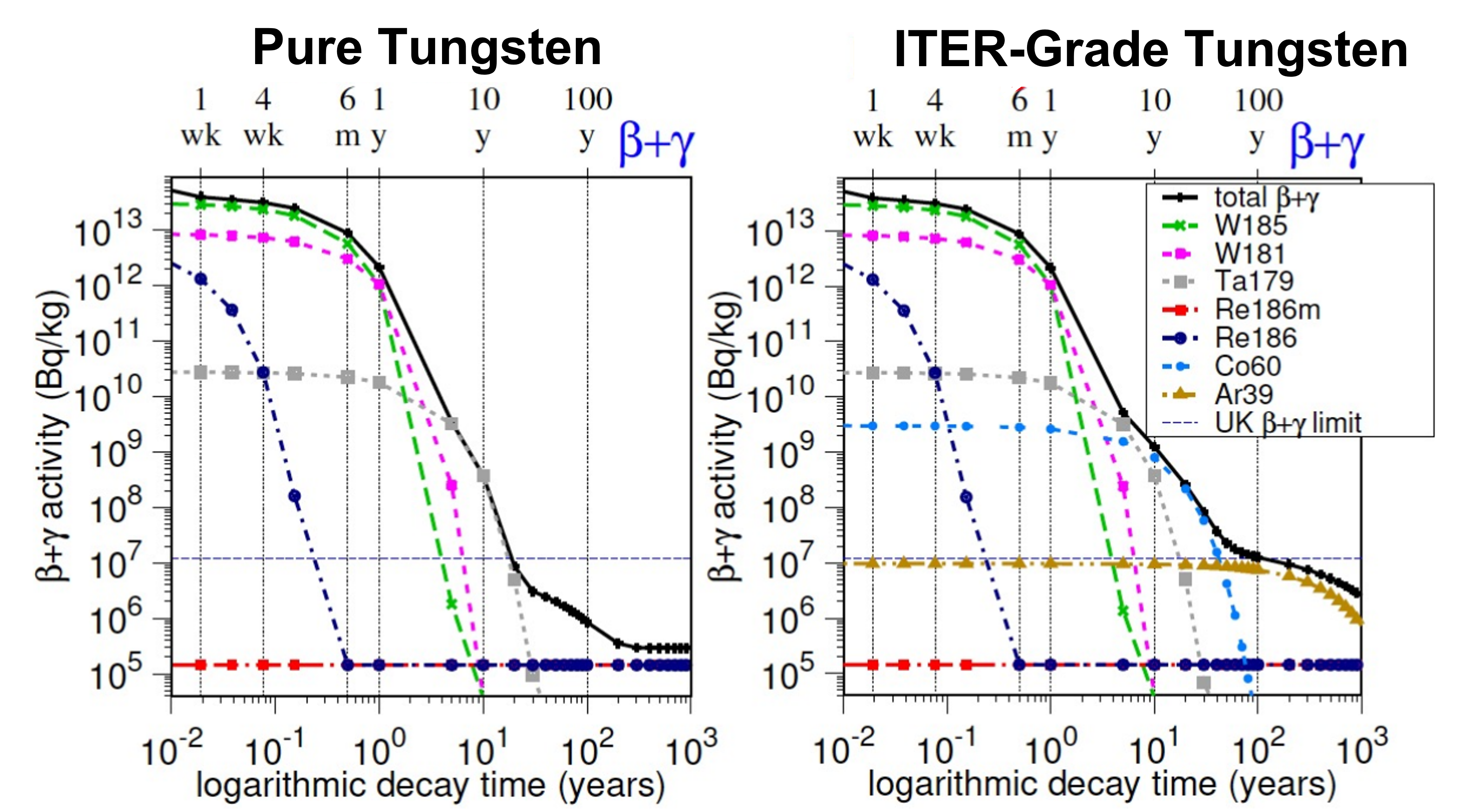
Examples of radioactivity decay curves for different grades of tungsten with different impurities.
Another problematic impurity in fusion reactor material is that of uranium in beryllium. Beryllium is necessary in breeder blankets as a neutron multiplier and the DEMO breeder blankets will contain about 560 tonnes of beryllium. The uranium impurity level differs in different Be supplies, but is typically 30 wppm, which would give about 17 kg of uranium in the blanket set. The plot below, taken from: Kolbasov et al., shows the activation processes. After 5 years of full power operation, the total amount of plutonium and other fissile isotopes produced would be about 4 kg.
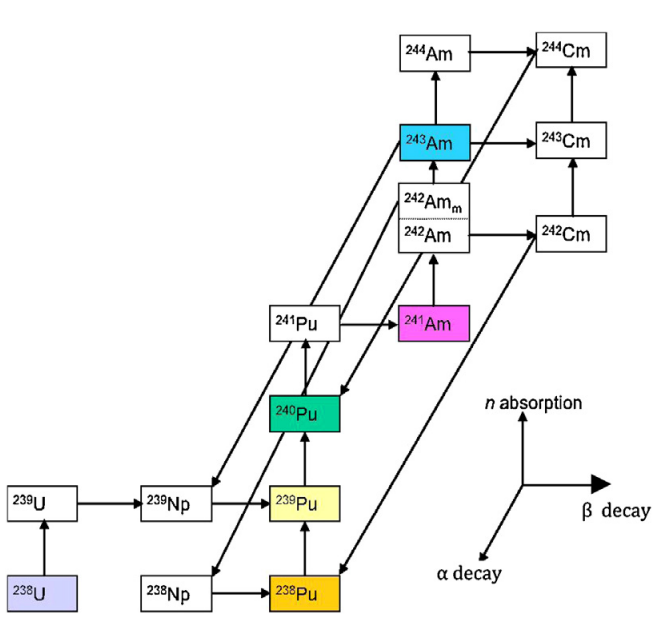
Activation processes for uranium impurity in beryllium
Radioactive waste, quantities for fusion and fission
To clarify the scale of the radioactive waste issue, in this section we compare the waste inventory of fission and fusion. The table below, from IAEA, shows the global waste situation from fission reactors.

Global total volumes of radioactive waste from all world fission reactors in 2018 for the different waste classifications: Very Low-Level Waste (VLLW); Low Level Waste (LLW); Intermediate Level Waste (ILW); High-Level Waste (HLW).
For fission the high-level waste causes most public concern. Public objections to geological waste sites are now fading away and the world's first deep repository, in Onkalo , is ready for use in Finland. After a decade or so, it is possible that all the world's HLW will be buried and safe. It is the ILW which will still pose disposal issues for fission, and it is this waste which will be produced in even larger quantities by fusion reactors.
Fusion reactors have much greater amounts of material subjected to a flux of high energy neutron than comparable fission reactors. Correspondingly, the volume of radioactive waste is much greater although the majority of it will have short lifetimes with only small quantities of the long-lived isotopes as mentioned above. This situation is analysed in a paper of Zucchetti et al., which concludes fusion reactors will have higher levels of short-lived radionuclides than fission reactors, but the situation reverses over time because of decay. The figure below gives a qualitative comparison of waste volumes in fusion and fission, with the studied US-DEMO (ARIES) reactor having 20 times higher volume of waste than a fission reactor.
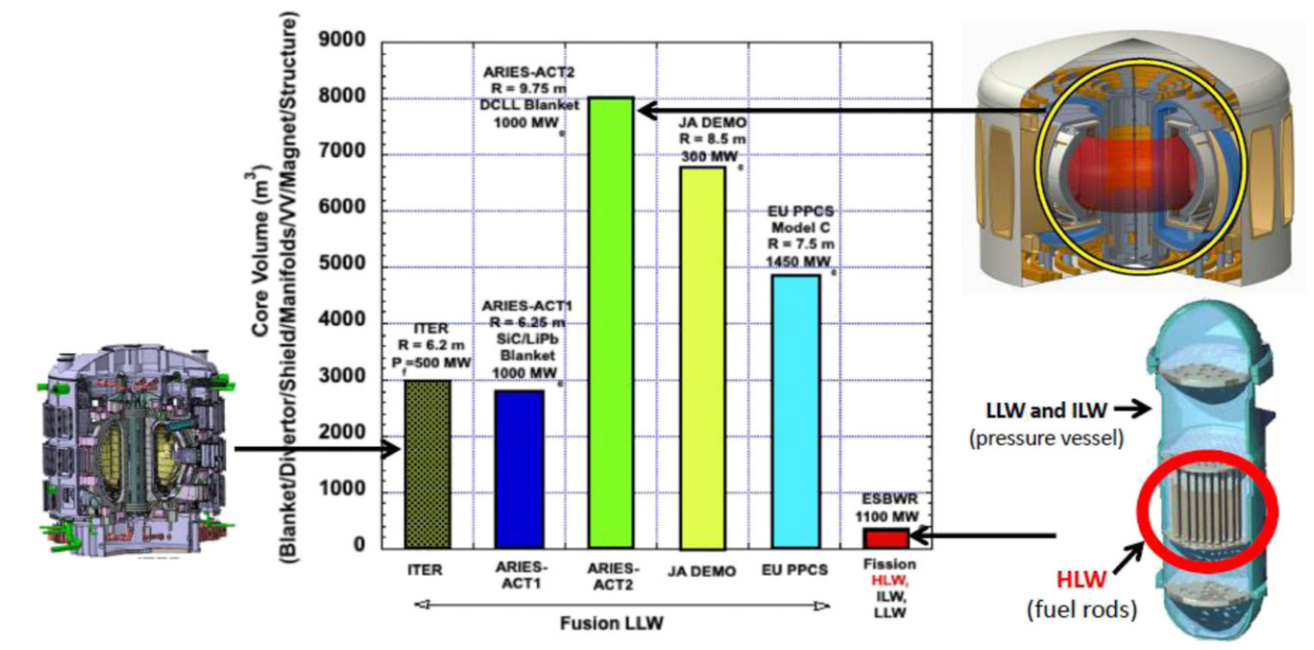
Indication of volume of radioactive waste for fusion reactors and fission reactors.